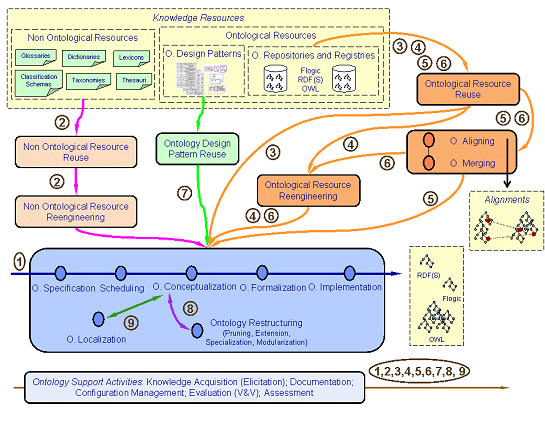The NeOn Methodology
The NeOn Methodology for building ontology networks is a scenario-based methodology that supports the collaborative aspects of ontology development and reuse, as well as the dynamic evolution of ontology networks in distributed environments. The key assets of the NeOn Methodology are:
- A set of nine scenarios for building ontologies and ontology networks, emphasizing the reuse of ontological and non-ontological resources, the reengineering and merging, and taking into account collaboration and dynamism.
- The NeOn Glossary of Processes and Activities, which identifies and defines the processes and activities carried out when ontology networks are collaboratively built by teams.
- Methodological guidelines for different processes and activities of the ontology network development process, such as the reuse and reengineering of ontological and non-ontological resources, the ontology requirements specification, the ontology localization, the scheduling, etc. All processes and activities are described with (a) a filling card, (b) a workflow, and (c) examples.

Scenario 1: From specification to implementation. The ontology network is developed from scratch (without reusing existing resources). Developers should specify ontology requirements (link to the guidelines). After that, it is advisory to carry out a search for potential resources to be reused. Then, the scheduling activity must be performed (link to the guidelines), and developers should follow the plan.
Scenario 2: Reusing and re-engineering non-ontological resources (NORs). Developers should carry out the NOR reuse process for deciding, according to the ontology requirements, which NORs can be reused to build the ontology network. Then, the selected NORs should be re-engineered into ontologies. Guidelines are provided in link to the guidelines.
Scenario 3: Reusing ontological resources. Developers use ontological resources (ontologies as a whole (link to the guidelines: link1, link2 ), ontology modules, and/or ontology statements (link to the guidelines)) to build ontology networks.
Scenario 4: Reusing and re-engineering ontological resources. Ontology developers reuse and re-engineer ontological resources.
Scenario 5: Reusing and merging ontological resources. This scenario arises when several ontological resources in the same domain are selected for reuse, and developers wish to create a new ontological resource with the selected resources. Related guidelines are provided in link to the guidelines.
Scenario 6: Reusing, merging and re-engineering ontological resources. Ontology developers reuse, merge, and re-engineer ontological resources. This scenario is similar to Scenario 5, but here developers decide to re-engineer the set of merged resources.
Scenario 7: Reusing ontology design patterns (ODPs). Ontology developers access repositories to reuse ODPs.
Scenario 8: Restructuring ontological resources. Ontology developers restructure (e.g., modularize, prune, extend, and/or specialize) ontological resources to be integrated in the ontology network.
Scenario 9: Localizing ontological resources. Ontology developers adapt an ontology to other languages and culture communities, thus obtaining a multilingual ontology. Guidelines for this scenario are provided in link to the guidelines.
You can find detail information about the NeOn Methodology in http://oa.upm.es/3879/
Created under Creative Commons License - 2015 OEG.

